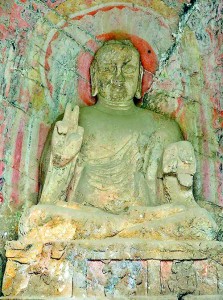Sunday Times 2
Ancient Buddha statue raises two fingers just like modern day anti-war sign
Flicking a peace sign is said to be the most-popular photo pose among the youth of east Asia, so it’s no wonder this stone Buddha statue in China has gained huge popularity.
The 24ft-tall Amita Buddha, located in the 104th cave of the famous Longmen Grottoes in Henan Province, appears to be posing with two fingers raised.

This ancient stone Buddha has gained new popularity thanks to it's 'peace' gesture
It is one of an estimated 100,000 statues of the Buddha and his disciples carved into the living rock of the 1,400 caves at Longmen, which date back nearly 2,000 years.
That would make is far older than the peace sign, which was first popularised as ‘V for victory’ in Europe during the Second World War, but then reversed in meaning by the peace movement in the U.S. during the 1960s.
At the same time as President Richard Nixon was flashing the gesture to prematurely claim victory in the Vietnam war, protesters flicked it palm out to call for an end to the conflict.
It is said to have spread in Asia during the post-War allied occupation of Japan, and from there, through cultural dissemination, across the rest of east Asia.
Nowadays, youths from South Korea to Communist China, and further afield, make the gesture as an almost instinctive reaction to finding themselves in the sights of a photographer.
The Amita Buddha was built during the reign of Li Zhi, also known as Emperor Gaozong of Tang, who ruled northern China between AD 650 and 683.
By the time he took to the throne, excavation of the man-made caves at Longmen was well underway as a flourishing of Chinese Buddhism led to a proliferation of devotional art.
Many of the stone Buddhas of Longmen are portrayed with their hands in a number of stylised gestures, known as Mudras, which have different meanings in and of themselves and in combination with others.
Disappointingly, this statue’s gesture is said to be purely a coincidence. Rex Features reports that its hand signal is the result of damage caused over the centuries.
© Daily Mail, London

